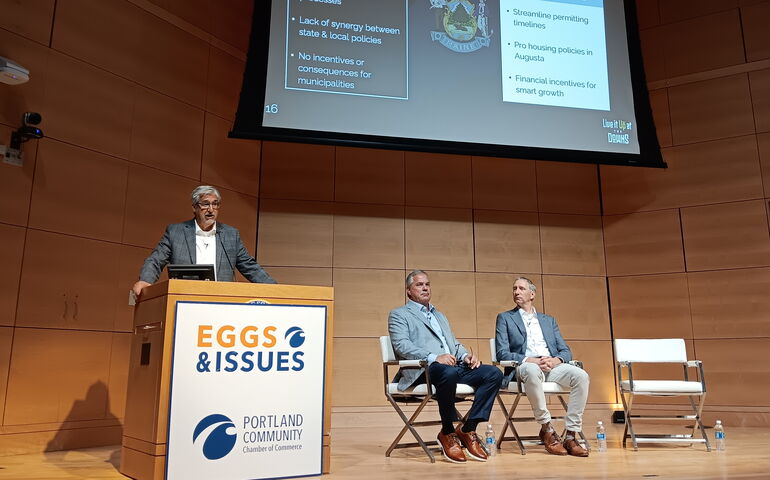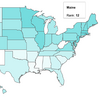Downs developers call for less NIMBY, more progressive zoning policies
 PHOTO / TINA FISCHER
Rocco Risbara, left, laid out some of the issues facing housing construction in Maine at an event in Portland on Thursday. Peter Michaud, center, and Dan Bacon are partners with Risbara in development at the Downs.
PHOTO / TINA FISCHER
Rocco Risbara, left, laid out some of the issues facing housing construction in Maine at an event in Portland on Thursday. Peter Michaud, center, and Dan Bacon are partners with Risbara in development at the Downs.
In order to boost desperately needed housing development in Maine, lawmakers at both the state and local level need to create more progressive zoning policies and fund more infrastructure — and anti-growth proponents need to get out of the way.
Such was the prescription from the development team at the Downs, the 577-acre mixed-use neighborhood being built off of U.S. Route 1 in Scarborough, where 622 new homes have been built and 1,400 more are planned.
Rocco "Roccy" Risbara, Peter Michaud and Dan Bacon — partners in M&R Holdings, which is developing the Downs — shared their thoughts yesterday at the Portland Regional Chamber of Commerce’s "Eggs & Issues" event, held at the University of Southern Maine campus. Risbara was honored as a Mainebiz Business Leader of the Year in 2020.
“The Downs is scalable, it can be done anyplace,” said Peter Michaud, who said implementing “smart growth” tools in communities is the key. “The town of Scarborough had a vision and planners created a comprehensive plan back in 2006 which designated growth areas for flexible, mixed-use zoning and they created a zone for density.”
TIFs and other incentives
In 2013 the town mapped the zoning for the Downs, when Bacon was Scarborough’s town planner. The town created a tax-increment financing district for the project, which Bacon explained allows the increase in assessed value created by the development to be sheltered from state revenue sharing.
“This results in the town retaining an additional 30 to 40 cents of every dollar of new tax revenue created in the TIF district," he said.
Sheltered revenue can be used by the town to pay down debt on capital projects, which Scarborough is doing for the bond on the new public safety building.
The Downs team bought the property in 2018 for $6.7 million. The property had been under contract 17 times over 15 years, and bids included a host of casino projects, which voters rejected, Michaud said.
M&R Holdings goal with the purchase was to create both housing and jobs
“We wanted to make a regional contribution not just to Scarborough. We have a passion for Scarborough, and for Maine, where I’ve lived for over 50 years,” he said.
A total of 2,000 homes planned
So far the Downs has created new homes for 1,000 residents, at a range of pricing levels and in a mix of housing types, from tiny homes to multi-family apartment complexes, townhouse condos and senior housing. Fifteen percent are single family homes.
About 16% of the units built are priced as “affordable," for households whose incomes do not exceed a prescribed percentage of the area median income.
“Three to four years ago when interest rates were 3% — not 6.5% — 40% to 60% of our housing was ‘workforce,'" Bacon said — that is, for incomes that do not exceed anywhere from 80% to 120% of area median income; the percentage can vary based on the project.
“But interest rates have really taken a bite out of our production of affordable housing," he added.
Despite the fact that the Downs is currently one of the two largest housing developments in the state, Brunswick Landing being the largest, Michaud noted, “At full build of 2,000 homes, we’ll create only 2.5% of the 80,000 homes the state needs.”
The Downs also has more than 50 businesses on site. Large tenants include Costco, IDEXX, Crown Lift Trucks and Throttle Car Club. A Market Basket is on deck, along with a 60,000-square-foot outpatient care center for Intermed. All told, Michaud said the Downs will provide 1,000 jobs.
Lack of incentives
The larger issues though, panelists stressed, are a lack of financial incentives and high costs for developers, not enough pro-housing policy from state government, and local approval processes that can too easily be affected by planning boards whose members change.
“Towns need to get their comprehensive plans in order,” Michaud said. "Smart growth doesn't have to be sprawl.”
Risbara added: “Augusta’s got to set some policy that flows down to the towns. Right now there are not a lot of incentives.
“And at the state level, the permitting process takes too long,” Risbara said. “The DEP (Department of Environmental Protection) has some great people. But there aren’t enough of them and they’re not paid enough."
Development fees can also "kill a project," Risbara said.
“Maine is the best place in the world to raise a family,” Risbara said. “And we have plenty of available land, but little infrastructure. There is a lot of opportunity — and a lot of barriers .... We’ve got to deal with the NIMBY’s .... Fear is derailing a lot of projects."













0 Comments